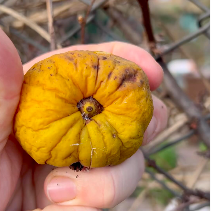”As we get closer to springtime I want to make the most of leftover fruits. Ornamental fruits are very interesting to me as are many leaves & blossoms. They often go overlooked & I remember seeing this fruit just go into the garden waste bin.
GeorgeFlavour Fred
Being ornamental they are choice for houses as they have an early flowers that cluster with 5 pink to red petals & yellow anther, beautiful leaves and then the fruit so great hedges in front gardens or can be trained to grow on the front of houses.
Quince (Cydonia oblongaas) is incredible and I’m so happy to have access to Japanese quince. For me I think the perfume is far more intense. When it comes to cooking I’ve used sweetness with them here & I also use them in my autumn liqueur but you’ll find many savoury dishes using them too especially in Eastern Mediterranean cuisine.
I simply peel & core the quince using the peel for a tea. Then boiling the flesh until it breaks down you need to strain out the liquid from the pulp. I do this by placing muslin over a bowl pouring in the contents of the pots & then taking the corners of the muslin tie together suspended above the bowl (normally on a cupboard handle). Do not squeeze the liquid to keep it clear (many leave overnight) & add 80% of the volume in sugar. Quince has pectin so it will set somewhat but you can use preserving sugar or carageen (seaweed) powder to get a jelly. The pulp then can be brought to the boil with equal weight of sugar and left to simmer for an hour. Looking for the thick paste look that when stirred will show the base of the pan. Line a vessel with parchment snipping the into the corners of the base. This can be folded to create nice space for it to set in. Leave overnight and the next day it will be set. Place in the fridge and slice when required.
Great with cheese and as a condiment. Most often known as Membrillo being served with Manchego where Membrillo is a translation of quince into Spanish.


 ZERO WASTE
ZERO WASTE 
